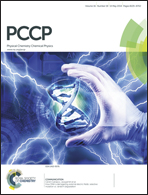Structural transformation of confined iodine in the elliptical channels of AlPO4-11 crystals under high pressure†
Abstract
Iodine molecules confined in the elliptical nanochannels of AlPO4-11 crystals can only rotate in the plane passing through the major axis of the elliptical cross-section due to size confinement. This leads to different dynamic behaviors of iodine from those confined in round channels of AlPO4-5 crystals under ambient conditions. In this work, we use high pressure technology to manipulate the nanoscaled iodine species confined in the elliptical channels of AlPO4-11 crystals. In situ polarized Raman measurements and theoretical simulations have been carried out to study the topological geometry of the confined iodine species upon compression. It was found that the population of iodine chains could significantly increase at the expense of standing iodine molecules under pressure up to 6 GPa, due to the pressure-induced rotation of standing iodine molecules. Besides, the contraction of the host framework along the channel axis favors the formation of iodine chains and strengthens the interaction of neighbouring molecules in a chain, consequently leading to a frequency redshift of the corresponding Raman mode. The different transformation dynamics of the confined iodine in AlPO4-11 crystals upon compression, compared to those in round channels of AlPO4-5 crystals, have been discussed in terms of the unique nanochannels that offer the quasi two-dimensional nanoscaled confinement environment.


 Please wait while we load your content...
Please wait while we load your content...